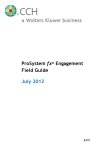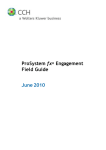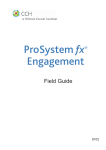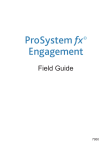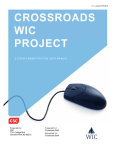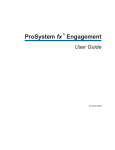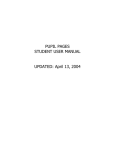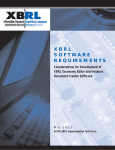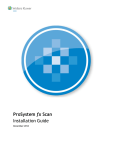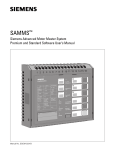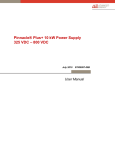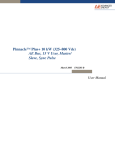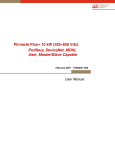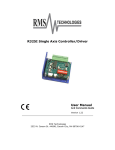Download ProSystem fx® Engagement Field Guide - Support
Transcript
ProSystem fx® Engagement Field Guide July 2015 © 2015 CCH, Incorporated. All Rights Reserved. Material in this publication may not be reproduced or transmitted, in any form or by any means, without prior written permission. Requests for that permission should be directed to: CCH INCORPORATED 20101 Hamilton Ave. Suite 200 Torrance, CA 90502 The contents of this publication are believed to be accurate. However, responsibility cannot be assumed for the information contained herein, and the consequences resulting from the use thereof. Material in this publication is subject to change without notice. This User Manual and the computer software it describes are designed to provide accurate and authoritative information in regard to the subject matter covered. They are distributed with the understanding that the publisher is not engaged in rendering legal, accounting, or other professional services. If legal advice or other expert assistance is required, the services of a competent professional should be sought. "ProSystem fx Engagement" is a registered trademark of CCH INCORPORATED. “Windows” is a registered trademark of Microsoft Corporation. All other brand, product, or company names are trademarks or registered trademarks of their respective owners. Printed in U.S.A. Table of Contents Overview 1 Local File Room 2 Client Index View 2 Engagement Today View 4 Binder Window 6 Binder View 6 Notes Summary View 13 Sign Off Summary View 14 Current Editor View (or Live Editor View) 15 Engagement Toolbar - File Room 16 Engagement Toolbar - Binder Window 19 Engagement Toolbars in Excel and Word 23 Engagement with the Microsoft Office Ribbon 23 Engagement Ribbon – Excel 23 Engagement Ribbon – Word 26 Adding Items - File Room 29 New Client Folder 29 New Binder 29 Adding Items - Binder Window 32 New Tab 32 New Workpaper 32 Contents • iii New Workpaper from Template 32 New Workpaper from File 33 New Trial Balance 33 New Manual Workpaper 33 New Placeholder 34 New Knowledge Coach Workpaper 34 New Workpaper from Scanner 34 Understanding the Trial Balance 36 Opening a Trial Balance 37 Parts of a Trial Balance 37 Using Trial Balance Functions 40 Setting Up Trial Balance Views 40 Setting Up Fund Trial Balance Views 41 Converting and Importing Trial Balance Data 41 Chart of Accounts 55 TB Edit Mode 56 Account Groupings 56 Setting up Funds 59 Journal Entries 60 Recording Transactions in Write-Up Trial Balances 62 Reports 63 JE Reports 63 Contents • iv Fund JE Reports 64 TB Reports 64 Fund TB Reports 67 Consolidated Reports 68 Write-Up Reports 69 Creating the Write-Up Detail Report 69 Creating G/L Current and G/L YTD Reports 70 Linking to the Trial Balance 71 Name and Date Links 71 Linking Trial Balance Data 72 Copying and Pasting TB Links 72 Inserting TB Link 73 Analyzing a TB Link Formula 74 Drill Down to Trial Balance Accounts 76 Advanced Trial Balance Functions 77 Exporting to Tax Software 81 Sharing Workpapers 83 Shared File Rooms 84 Synchronize Binder 86 Synchronize Individual Workpapers 88 Express Synchronization 89 Binder Packages 89 Contents • v Reviewing Workpapers 93 Workpaper Notes 93 Creating a Workpaper or Workpaper Tab Note 93 Responding to, Clearing, or Deleting a Note 94 Workpaper Sign Off 95 Lock/Unlock Workpapers 96 Freeze/Unfreeze Workpapers 96 Tickmarks 97 Workpaper Reference Links 99 Inserting Workpaper Reference Links Opening Referenced Workpapers 99 100 Publishing Workpapers 100 Other Common Features 102 Creating Templates 102 Saving TB Link Formulas 106 Renaming Items 106 Deleting Items 107 Getting More Information 108 Contacting ProSystem fx Engagement 108 Technical Support 108 Product Updates, FAQs, and More 109 Appendix 110 Contents • vi TB Report Sample Settings Notes 110 113 Contents • vii Overview Overview The Field Guide is designed to be used as a quick reference for experienced users of ProSystem fx Engagement. This Field Guide is ideal to use as a supplement to our training courses. It describes the most common way to perform tasks. Refer to the ProSystem fx Engagement User Guide for a more comprehensive explanation of these functions and all of the ways to perform them. You can access the User Guide from the Help Menu in ProSystem fx Engagement. 1 Local File Room Local File R oom There are two views for the local file room: Client Index view and Engagement Today view. Client Index View 1. Client Index Pane. This area of the File Room displays client folder information. The Client Folders hold your Engagement binders. 2. Contents Pane. This area displays the contents of the selected item in the Client Index Pane. These could be client folders or binders. You can sort items shown in this pane by clicking the column headers. 2 Local File Room 3. Remote File Rooms Pane. This area contains three tabs: CFR (Central File Room). Lists all CFRs set up for the firm. If you have logged in from the Field, you will not see the CFR tab. Staff. Lists all staff members. Buddy List. Lists the staff members you have added to your Buddy List. 3 Local File Room Engagement Today View Engagement Today displays user-level diagnostic information that summarizes key statistics regarding the binders in your local file room. Engagement Today also displays the Tip of the Day. Note: Engagement Today is not available from a shared file room. The Engagement Today view displays five panes: 1. My Recent Binders. Displays links to the last four binders used. 2. By Lead Partner. Displays a list of binder links sorted by lead partner from the binder properties. 4 Local File Room 3. Other Highlights. Displays a list of binder links sorted by specific criteria. 4. By Engagement Type. Displays a list of binder links sorted by the categories listed. 5. Tip of the Day. Displays suggestions for using the program more efficiently. You can hide the Tip of the Day by clicking Hide Tips. Click Previous and Next to navigate through the tips. 5 Binder Window B inder Window To open a binder, double-click the binder in the file room. The Binder window is made up of four views: Binder View Notes Summary View Sign Off Summary View Current Editor View (or Live Editor View) Binder View The Binder View displays the contents of the binder and the status of the workpapers in the binder. 6 Binder Window 1. Shortcut Bar. The Shortcut Bar provides quick access to many Engagement functions, including Workpapers, the Binder Snapshot, the Trial Balance Snapshot, the Knowledge Coach Web Site, and Capital Confirmation electronic audit confirmation service. If ProSystem fx Suite is installed, a shortcut to the Dashboard is also available. 2. Binder Index Pane. The Binder Index Pane includes the following folders: Binder. The Binder name displays beside one of the following images, based on the Document Completion Date: Icon Name/Description Standard binder. The user is not the current editor of any workpapers in the binder, and the document completion date is not approaching or past due. Current Editor. The user is the current editor of at least one workpaper in the binder, and the document completion date is not approaching or past due. 7 Binder Window Icon Name/Description Document Completion Date Approaching. The user is not the current editor of any workpapers in the binder, and the document completion date is within the specified number of days (i.e., 45 or 60 days) from the current date. Document Completion Date Approaching and Current Editor. The user is the current editor of at least one workpaper in the binder, and the document completion date is within the specified number of days (i.e., 45 or 60 days) from the current date. Document Completion Date Past Due. The user is not the current editor of any workpapers in the binder, and the document completion date set for the binder is past due, so all changes made the binder must be documented. 8 Binder Window Icon Name/Description Document Completion Date Past Due and Current Editor. The user is the current editor of at least one workpaper in the binder, and the document completion date set for the binder is past due, so all changes made the binder must be documented. Finalized Binder. The binder has been finalized. Finalized Binder Partially Synchronized. The binder has been finalized but errors occurred during synchronization, or the binder synchronization was stopped by the user and is only partially synchronized. Note: If you are Current Editor of a binder, a current editor designation arrow displays on top of the appropriate binder icon above. 9 Binder Window Unfiled Workpapers. This folder stores workpapers that have not been filed yet. Reports generated by ProSystem fx Engagement originally appear here. You can then move each report to the desired workpaper tab section. Conflicts. This folder stores workpapers in conflict after synchronization or from binder packages that have been received. Incompatible Workpapers. This folder displays if you have Knowledge Coach installed. It stores Knowledge Coach workpapers that could not be filed in the active binder because the title version of the workpaper is not compatible with the title version of the binder. Published Workpapers. This folder stores copies of Word or Excel workpapers where the formulas (such as, trial balance links) have been automatically converted to values. Trash. This folder contains the workpapers you delete in ProSystem fx Engagement. If you have deleted a workpaper by mistake, you can restore it and it will be filed back to the appropriate tab. The Binder folder contains tabs that organize the workpapers. Workpaper properties display in columns 10 Binder Window to the right of the Binder Index column and include the following: Index Number and Name. The alphanumerical index number is optional. The name is required, and it describes the content of the workpaper. Locked. A locked paper is read-only. Frozen Links. If the Engagement links in the selected workpaper are frozen, this icon displays. Note. If a note has been created for this workpaper or workpaper tab, this icon displays. Modified after Reviewer Sign Off. If the administrator has chosen to flag workpapers that have been modified after a reviewer has signed off, this icon displays as appropriate. Prepared By. When a workpaper is signed off by a preparer, the date and preparer’s initials display. Reviewed By. When a workpaper is signed off by a reviewer, the date and reviewer’s initials display. 2nd Reviewed By. When a workpaper is signed off by a second reviewer, the date and reviewer’s initials display. 11 Binder Window File Modified Date. The date and time the workpaper was last changed. Current Editor (if viewing a non-shared file room). The staff member who has checked out this workpaper. Live Editor (if viewing a shared file room). The staff member who has this workpaper open. If no staff member has the workpaper open, then <Available> displays if the file room's host is current editor of the workpaper. <Unavailable> displays if the host is not the current editor. Assigned To. The team member who the current editor has assigned the workpaper to prior to synchronizing. (Does not display in shared file rooms.) 3. Notes Pane. When a workpaper or tab with a note is selected in the Binder window, information about the following displays: subject, number of responses, who it is from and assigned to, the date created, who cleared the note, and the date cleared. Note: If Knowledge Coach is installed, a Diagnostic pane also displays above the Notes pane. 12 Binder Window Notes Summary View The Notes Summary View displays all of the notes that exist in the binder. The Notes are broken down into three types: Team Notes Open Items Notes for Next Period 13 Binder Window Sign Off Summary View The Sign Off Summary View displays the level of review for all of the workpapers that exist in the binder. The level of review is broken down into three stages: In Process Ready for Review Reviewed Team members that have signed workpapers off are listed, with the sign off date, under each workpaper. 14 Binder Window Current Editor View (or Live Editor View) If you are viewing a non-shared local file room, the Current Editor View tab is available. The Current Editor View displays all of the team members assigned to the binder. Displayed under each team member is a list of the workpapers they have checked out. Any workpaper not checked out to a team member appears in the Unassigned section. If you are viewing a shared local file room, the Live Editor View tab is available. The Live Editor View displays all the staff members who are currently working on a workpaper in the binder. Under each staff member is a list of the workpapers he or she is working on. Any workpapers that are not being worked on are listed in the Unassigned section. 15 Engagement Toolbar - File Room Engagement T oolbar - File R oom The Engagement toolbar in the File Room window consists of the following buttons: New Client. Creates a new client folder. New Binder Wizard. Creates a new binder. Assign Binder Staff. Adds team members to a binder. Open. Opens the selected item. Open Trial Balance. Opens the trial balance in a selected binder. If there is more than one trial balance, a list appears for you to select from. Cut. Cuts item(s) to the clipboard. Copy. Copies item(s) to the clipboard. Paste. Pastes item(s) from the clipboard. Expand All. Expands the entire tree. Collapse All. Collapses the entire tree. 16 Engagement Toolbar - File Room Properties. Displays properties of the selected item. Refresh. Refreshes the local file room or central file room. Create Binder Package. Creates a single file (compressed) of a binder to send to other Engagement users. Receive Binder Package. Receives a binder package created by another Engagement team member. Synchronize Binder. Opens the Synchronize Binder Wizard. Express Synchronization. Automatically synchronizes the binder to the central file room without opening the Synchronize Binder Wizard. Tax Software Interface. Exports trial balance data to tax vendors. Finalize Binder. Opens the Finalize Binder Wizard for the selected binder. Roll Forward. Opens the Roll Forward Wizard for the selected binder. 17 Engagement Toolbar - File Room Client Inquiry. Opens the ProSystem fx Practice Client Inquiry Module. Engagement Today. Displays the Engagement Today view. Client Index. Displays the Client Index view. Check In All Workpapers. Checks in all eligible workpapers in the binder. Check Out All Workpapers. Checks out all eligible workpapers in the binder and synchronize the full binder. Client Group Filter. Filters the clients in the file room by client group. 18 Engagement Toolbar - Binder Window Engagement T oolbar - B inder Window The Engagement toolbar displayed in the Binder window consists of the following buttons: New Tab. Creates a new workpaper tab. New Workpaper from Template. Creates a new workpaper from predefined templates. New Workpaper from File. Inserts into the binder a new workpaper from an Excel, Word, or other file type. New Trial Balance. Creates a new trial balance. New Manual Workpaper. Creates a workpaper to serve as a placeholder for a physical workpaper not inserted into the Binder. New Placeholder. Creates a name and index number for a workpaper that will be added at a later date from a file or scanned document. New Knowledge Coach Workpaper. Creates a new workpaper from the Knowledge Coach Workpaper Templates. Requires installation of Knowledge Coach titles. New Workpaper from Scanner. Creates a new workpaper from a TWAIN-compliant scanner. 19 Engagement Toolbar - Binder Window Open. Opens the selected item. Open Trial Balance. Opens the trial balance. If there is more than one trial balance, a list appears for you to select from. Print. Prints the selected workpaperor report. Cut. Cuts item(s) to the clipboard. Copy. Copies item(s) to the clipboard. Paste. Pastes item(s) from the clipboard. Properties. Displays properties of the selected item. Expand All. Expands Binder Views to show all workpapers. Collapse All. Collapses Binder Views to hide all workpapers. Refresh. Refreshes and re-sorts Binder tabs and workpapers. Publish Workpaper. Publishes a workpaper to convert formulas to values. Lock Workpaper. Locks a workpaper as readonly. Unlock Workpaper. Unlocks a workpaper. 20 Engagement Toolbar - Binder Window Freeze Links. Freezes Engagement links in the selected workpaper so that links are not refreshed. Unfreeze Links. Unfreezes Engagement links for the selected workpaper. Create Workpaper Note. Creates a note for the selected workpaper. Sign Off Workpaper Properties. Opens the Workpaper Properties dialog. Sign Off As Preparer. Adds sign off initials in the Prepared by column. Sign Off As 1st Reviewer. Adds sign off initials in the Reviewed by column. Sign Off As 2nd Reviewer. Adds sign off initials in the 2nd Reviewed by column. Tax Software Interface. Exports data to tax packages. Binder View. Displays binder contents and workpaper status. Notes Summary View. Displays workpaper and workpaper tab notes by type. Sign Off Summary View. Displays workpapers sorted by level of review. 21 Engagement Toolbar - Binder Window Current Editor View/Live Editor View. Displays workpapers sorted by current editor or live editor. 22 Engagement Toolbars in Excel and Word Engagement T oolbars in Excel and Word Engagement with the Microsoft Office Ribbon Engagement takes advantage of the Ribbon interface in Excel and Word. The Engagement tab displays all of the functions you need to complete workpaper tasks. The Workflow group of the Engagement tab includes the six most recently used tickmarks. Engagement Ribbon – Excel The Microsoft Excel Ribbon consists of the following buttons: QuickView. Displays the balance broken down by assets, liabilities and equity, revenue, expenses, and net income. Refresh. Refreshes all links in the workpaper, including Name, Date, and Trial Balance Links. Properties. Enables you to view and modify trial balance and trial balance report properties. 23 Engagement Toolbars in Excel and Word Copy TB Link. Links data from your trial balance to your workpapers or financials. This information updates with trial balance changes. Quiklink. Links between a trial balance and the ProSystem fx Tax return. Create WP Note. Creates a note for the workpaper. Insert WP Reference. Inserts a reference link to another workpaper in the binder. Open WP Reference. Opens the referenced workpaper. Add Journal Entry. Adds a journal entry. JE Summary. Displays current journal entries by type. You can add, modify, or delete journal entries from this window. WU Journal Entry. Organizes the transaction data in journals. 24 Engagement Toolbars in Excel and Word Chart of Accounts. Allows you to add, modify, and delete trial balance accounts. You can also add balances to different columns in the trial balance. TB Edit Mode. When toggled on, allows you to make changes to the trial balance directly. Import. Assist in importing trial balance data from other supported trial balance software programs. Consolidate TB. Consolidates data from single company trial balances into a consolidated trial balance. Account Groupings. Opens the Account Groupings window. Classifications. Allows you to view and edit account and ratio classifications. Funds Setup. Opens the Funds Setup dialog where you can add, edit, or delete funds for the selected trial balance. This is available for fund trial balances only. 25 Engagement Toolbars in Excel and Word Create. Create TB, Consolidated, Journal Entry, Fund TB, Fund JE, or Write-Up reports. View. Switch to any view you created in your trial balance. Group. Switch to any grouping list you created in your trial balance. TB Column Setup. Opens the TB Column Setup window where you can modify the columns displayed in the trial balance. Select Funds. Displays the Select Funds dialog where you can setup fund types, fund subtypes, and funds and then assign accounts directly to these funds. This is available for fund trial balances only. Engagement Ribbon – Word The Microsoft Word Ribbon consists of the following buttons: QuickView. Displays the balance broken down by assets, liabilities and equity, revenue, expenses, and net income. 26 Engagement Toolbars in Excel and Word Refresh. Refreshes all links in the workpaper, including Name, Date, and Trial Balance Links. CCH Footnote. Inserts a CCH footnote. Insert TB Link. Creates links from the trial balance, without having to open the trial balance. Paste TB Link. Links data from your trial balance to your workpapers or financials. This information updates with trial balance changes. Drill-down TB Link. Drills down to the accounts included in the linked formula. Name Functions. Inserts Client, Engagement, and Firm information links. Date Functions. Inserts Current and Prior date links. Freeze TB Links. Freezes Engagement links for the workpaper so that links are not refreshed. Replace TB Link Name. Replaces trial balance link names and updates links. 27 Engagement Toolbars in Excel and Word View Field Codes. Toggles all links in Word on/off. When on, you can view and edit Engagement formula links directly. Insert WP Reference. Inserts a link to another workpaper in the binder. Open WP Reference. Opens the referenced workpaper. Create WP Note. Creates a note for the workpaper. Tickmarks. Displays the tickmark toolbar. Add Journal Entry. Adds a journal entry. JE Summary. Enables you to add, modify, or delete journal entries. WU Journal Entry. Organizes the transaction data in journals. Setup. Access trial balance setup functions. 28 Adding Items - File Room A dding Items - File R oom New Client Folder 1. Click New Client on the toolbar. 2. Enter the client’s information on the Profile tab. 3. Click the Groups tab to assign the client to a client group. 4. Click the Contacts tab to enter contact information. 5. Click OK when finished. New Binder 1. Click New Binder Wizard on the toolbar. 2. Click Next on the Welcome dialog. 3. Select the client folder and click Next. 4. Select a central file room and click Next. 5. Select the source for the binder: Create binder from template. a. Select the tab containing the template. b. Select a template and click Next. Create blank binder (no tabs or workpapers). Click Next. 29 Adding Items - File Room Create binder from existing binder in your local file room. a. Select client folder that contains the binder. b. Select the binder to use and click Next. 6. Enter the general properties of the binder and click Next. 7. Enter period information for the binder and click Next. 8. If you selected a template or existing binder with Knowledge Coach workpapers, the Knowledge Coach options page displays. Select the needed options, and then click Next. 9. Assign additional teams or staff to the binder by clicking the Assign buttons. Note: To assign staff members after a binder has been created, select the binder in the File Room and then select File/Properties. On the Binder Staff tab, click the Assign button. 10. Click Finish. 11. Review the New Binder Summary Report and click Create to create the binder. 30 Adding Items - File Room 12. If this is a Knowledge Coach binder and you have selected to update content, you will need to select which title version to update to before the new binder can be created. 31 Adding Items - Binder Window A dding Items - B inder Window New Tab To add a new tab, do the following: 1. In the Binder Index, right-click where you want the new tab. 2. Select New Tab from the list. 3. Enter the Name (required) and Index #. 4. Click OK. New Workpaper You can add a workpaper in one of the following ways: New Workpaper from Template 1. Right-click the tab where you want the new workpaper. 2. Select New Workpaper from Template. 3. Select the tab containing the template. 4. Select the template to use and click OK. 5. Enter the Name (required) and Index #. 6. Click OK. 32 Adding Items - Binder Window New Workpaper from File 1. Right-click the tab where you want the new workpaper. 2. Select New Workpaper from File. 3. Choose the location in the Look in field. 4. Select the file to insert and click OK. 5. Enter the Name (required) and Index #. 6. Click OK. New Trial Balance 1. Right-click the tab where you want the new workpaper. 2. Select New Trial Balance. 3. Select the tab containing the template. 4. Select the template to use and click OK. 5. Enter the Name (required) and Index #. 6. Click OK. New Manual Workpaper 1. Right-click the tab where you want the new workpaper. 2. Select New Manual Workpaper. 3. Enter the Name (required) and Index #. 4. Click OK. 33 Adding Items - Binder Window New Placeholder 1. Right-click the tab where you want the new workpaper. 2. Select New Placeholder. 3. Enter a Name (required) and Index #. 4. Click OK. New Knowledge Coach Workpaper 1. Right-click the tab where you want the new workpaper. 2. Select New Knowledge Coach Workpaper. 3. Select an industry. 4. Select the workpapers from the industry. 5. Click OK. 6. If needed, you can do the following for each workpaper to be inserted: Enter an index Change the workpaper name Select the roll forward options New Workpaper from Scanner 1. Right-click the tab where you want the new workpaper. 2. Select New Workpaper from Scanner. 34 Adding Items - Binder Window 3. Select your scanner from the Scanner dropdown menu and click Scan. 4. Adjust any settings, and begin the scan according to your scanner's user guide. 5. Review a thumbnail image of each scanned page and click Scan More or Finish. 6. Enter the Name (required) and Index #. 7. Click OK. 35 Understanding the Trial Balance U nderstanding the T rial B alance While Trial Balances appear to be normal Excel files, they actually represent the databases that store all of your data. The types of trial balances are as follows: Standard single company trial balance Consolidated trial balance Fund trial balance Write Up trial balance Trial balances created with a version of Engagement prior to 6.0 must be converted to Microsoft SQL Server database files. To do this, select Start > Programs > ProSystem fx Engagement > Utilities, and then click ProSystem fx Engagement Trial Balance Conversion Wizard. The wizard instructions will guide you through the conversion process. If you prefer, trial balances can be converted when binders are synchronized in ProSystem fx Engagement. Note: See Advanced Trial Balance Functions on page 77 for details on creating consolidated, fund and write up trial balances. 36 Understanding the Trial Balance Opening a Trial Balance Click Open Trial Balance from the Binder window. This launches Excel, allowing you to view the trial balance. Note: If you have more than one trial balance in your binder, a window displays listing all trial balances. Select the appropriate trial balance and click OK. Parts of a Trial Balance There are three areas in the trial balance that allow you to change the way information is displayed. Changing the View. You can switch to any view you created in your trial balance from the View drop-down menu. The columns to the right of the Account and Description columns change based on your settings for that view in the TB Column Setup. Examples of column descriptions are Unadjusted Balance, Final Balance, and Prior-Period Final Balance. See Setting Up Trial Balance Views on page 40 for further details. 37 Understanding the Trial Balance Changing the Fund View. You can modify the views of the new fund worksheets using Select Funds to change the columns that are displayed by selecting the period, balance type, and funds you want to view. You can also select to hide fund and total columns. Changing the Grouping List. You can switch to any grouping list you created in your trial balance from the Group drop-down menu. Different groups and sub-groups display in the Account Group Summary and Account SubGroup Summary tabs. See the following section, Changing Worksheet Tabs, for details on worksheet tabs. The Account column displays the group or subgroup index numbers you created. The Description column displays the group or subgroup descriptions you created. The Grouping lists are created, modified, and deleted from the Account Grouping window. See Account Groupings on page 56 for further details. 38 Understanding the Trial Balance Changing Worksheet Tabs. You can navigate among worksheets using the following tabs: Account Detail. This tab displays the trial balance by account number. Subtotaling cannot be performed on this worksheet. You can manually add subtotals to TB Reports generated from the trial balance. Account Group Summary and Account Sub-Group Summary. These tabs display the totals for each group or subgroup you created in the Account Grouping window. Change the Grouping List from the Group toolbar drop-down to change which groups or sub-groups you want displayed. Fund Group Summary. This tab displays groups and balances for funds and, if selected, shows the totals for the fund types and subtypes. Fund Sub-Group Summary. This tab displays the subgroups and balances for funds and, if selected, shows the totals for the fund types and subtypes. 39 Using Trial Balance Functions U sing T rial B alance Functions Setting Up Trial Balance Views 1. Select TB Column Setup from the Trial Balance menu in the Binder window. 2. In the Trial Balance field, select the trial balance with the columns you want to modify. 3. In the View field, select the view with the column setup you want to modify. Click Options to create a new view. 4. In the Available Columns field, select the period that contains the columns you want to select from. Select the available column on the left side and then select the right-pointing arrow to add the column to your view. 5. To add a variance column, click Add Variance and select the appropriate information in the Column Properties section. 6. Click Close to save your changes. 40 Using Trial Balance Functions Setting Up Fund Trial Balance Views 1. From the trial balance, click Select Funds from the View group on the Engagement ribbon. 2. In the Balance section, select the Period and Balance type for the fund and total columns in the fund worksheets of the trial balance. 3. Select the fund types, fund subtypes, and funds in the tree control that you want to display in the fund trial balance. 4. Select the options you would like for the fund worksheets. 5. Select OK to close the dialog and refresh the columns of the fund trial balance worksheet. Converting and Importing Trial Balance Data You can convert trial balance data from other supported trial balance software packages into an Engagement trial balance. You can also import trial balance data from another Engagement trial balance. For other cases, import the information using the Paste TB Import function. 41 Using Trial Balance Functions Converting Trial Balance Data from ProSystem fx Write Up or ProSystem fx Trial Balance 1. Select Import Conversion Wizard from the Trial Balance menu in the Binder window. 2. Choose the source of your conversion file. 3. Click Next. 4. Select the ProSystem fx Engagement trial balance you want to transfer the data into from the Select Trial Balance drop-down list. 5. Select the ProSystem fx Trial Balance or WriteUp file from the Select export file drop-down list. If applicable, the default file or file extension is displayed to assist you. 6. Select the appropriate current period information, tax information, chart of accounts settings, and lead classifications options, as necessary. 7. Click Finish. Converting Trial Balance Data from ATB for Windows, GoSystem Audit, or an ASCII Text File 1. Select Import Conversion Wizard from the Trial Balance menu in the Binder window. 2. Choose the source of your conversion file. 3. Click Next. 42 Using Trial Balance Functions 4. Select the ProSystem fx Engagement trial balance you want to transfer the data into from the Select Trial Balance drop-down list. 5. Select the source file for import. 6. Select the number of prior periods. 7. If importing from an ASCII Text file, select whether the source file is comma delimited or tab delimited. 8. If importing from GoSystem Audit, select the balance type to convert. 9. Click Next. 10. If importing from GoSystem Audit, do the following: a. Select whether to convert all groupings, convert all and map to one Engagement grouping, or map to one Engagement grouping. b. If you are mapping groupings, select the GoSystem Audit grouping to map from on the left, and select the ProSystem fx Engagement grouping to map to on the right. c. Select the appropriate options for converting tax codes, if necessary. d. Click Next. 43 Using Trial Balance Functions 11. On the Chart of Accounts screen, click the gray bar at the top of each column to select the appropriate header information. You can assign only one trial balance column to each column of imported data. 12. Select whether to append or overwrite the data in the existing trial balance. 13. Select the appropriate rounding options as necessary. 14. Click Next. 15. Click Yes. 16. Click OK to begin the conversion. The Summary screen displays. 17. Click Finish. 44 Using Trial Balance Functions Importing from Creative Solutions Accounting With Creative Solutions Accounting, you can import annual, semi-annual, quarterly, and monthly standard balances. Important! Weekly, 13-period, budget and other balances, and write-up trial balances are not supported. To import client data from Creative Solutions Accounting into an Engagement trial balance, complete the following: 1. Select Import Conversion Wizard from the Trial Balance Menu in the Binder Window. 2. Choose the source of your conversion file and click Next. 3. From the Engagement trial balance drop-down list, select the ProSystem fx trial balance you want to transfer into. Engagement Consolidated and Engagement Write-Up trial balances are not supported. 4. Select the client file (*.wsw or *.wsz file) to import, or click Browse to select a file. Note: If the CSA database is password protected, enter your password. 45 Using Trial Balance Functions 5. In the Chart of accounts information section, select whether to append or overwrite the existing data in the Engagement trial balance data. 6. Select the appropriate rounding options as necessary. 7. Check the All active periods in CSA are closed (recommended) box, if you do not want to import current period CSA data. When selected, the CSA balance type to import as Engagement current unadjusted balance field is disabled. 8. If converting CSA tax codes to Engagement tax code assignments, select the appropriate options in the Tax information section. Click Next. 9. In the Account groupings section, select one of the following: Convert all CSA account groups and grouping schedules Convert all CSA groups and schedules and map one schedule to one Engagement grouping Map the accounts from one CSA schedule to one Engagement grouping 46 Using Trial Balance Functions Note: Accounts assigned to CSA account groups will not be assigned to the groups in the resulting Engagement grouping list since the assignment of ranges of accounts is not supported in Engagement. After the import is complete, you can map the accounts to the appropriate groups and subgroups using the Account Grouping option in Engagement. 10. If you are mapping a CSA grouping schedule, first select the applicable CSA grouping schedule and Engagement grouping list. Then, select the CSA codes or subcodes to map from on the left, and select the Engagement groups or subgroups to map to on the right. 11. Click Finish. Importing Data from CaseWare 1. Select Import Conversion Wizard from the Trial Balance menu in the Binder window. 2. Choose the source of your conversion file and click Next. 3. Select the ProSystem fx Engagement trial balance you want to transfer the data into from the Select Engagement trial balance drop-down list. 47 Using Trial Balance Functions 4. Select the client file for import. Note: Only client files with the extension .ac are accepted. Compressed files with the extension .ac_ are not accepted. 5. Select the CaseWare entity. 6. In the Chart of accounts information section, select the period sequence, the current CaseWare period to import into Engagement, and the CaseWare current period balance type. 7. Select whether to append to or overwrite the existing data in the Engagement trial balance data. 8. Select the appropriate rounding options as necessary. 9. Select one of the following: Convert all groupings Convert all and map to one Engagement grouping Map to one Engagement grouping 10. If you are mapping groupings, select the CaseWare grouping to map from on the left, and select the ProSystem fx Engagement grouping to map to on the right. 11. Click Finish. 48 Using Trial Balance Functions Importing TB Data from a QuickBooks Excel TB Report 1. Export the QuickBooks Trial Balance report to Excel. Note: You must select the Use account numbers and Show lowest subaccount only in QuickBooks. 2. Insert the QuickBooks Excel report in the binder (optional). 3. Do one of the following: If the Excel report is in the binder, select Import/Import Excel QuickBooks Data from the TB Setup lookup item on the Engagement ribbon. If the Excel report is not inside the binder: i. Open the Engagement trial balance where the data is to be imported. ii. Open the QuickBooks Excel report and select Import Excel QuickBooks Data on the Engagement ribbon. 49 Using Trial Balance Functions iii. Navigate to the Engagement trial balance and click Paste TB Import. 4. Define the columns by clicking the gray column header bar and selecting the appropriate column description from the menu that appears. Do this for all columns you want to import. Do not define the header for those you do not want to import. 5. Do one of the following: Select Append to add your current data to the existing trial balance. Select Overwrite to destroy all existing account data and journal entries. The accounts must be regrouped. Overwrite also unassigns all previous group and sub-groupings. 6. Correct duplicated account numbers, invalid accounts, and blank fields highlighted during import. 7. To round balances, select the place to round the account balances to in the Round Balance to Nearest field and complete the Select Rounding Account field. 8. Click Next. 9. Click Yes. 50 Using Trial Balance Functions 10. Click OK. 11. Review the statistical information and click OK. Importing TB Data From an Excel File 1. Open the trial balance. 2. Open the Excel file containing your trial balance data. 3. Do the following to prepare the content for import: Organize the data so that there are no blank rows in the data range. Remove any of the following characters from the account number and balance columns: ' : " , | ( ) * ?. Verify that the total of each balance column nets to zero. 4. Select the range of data, excluding any column headers or balance checks, and select Edit > Copy in Excel. 5. Switch to the trial balance by selecting it from the window menu in Excel. 6. Click Paste TB Import. 7. Define the columns by clicking the gray column header bar and selecting the appropriate column description from the menu that 51 Using Trial Balance Functions appears. Do this for all columns you want to import. Do not define the header for those you do not want to import. Important information when a fund trial balance is selected! When a fund trial balance is selected, the Fund Index can be selected as a column heading or the Fund Mask option can be defined on the Fund Mask tab of the Funds Setup dialog. 8. Do one of the following: Select Append to add your current data to the existing trial balance. Select Overwrite to destroy all existing account data and journal entries. The accounts must be regrouped. Overwrite also unassigns all previous group and sub-groupings. 9. Correct duplicated account numbers, invalid accounts, and blank fields highlighted during import. 10. To round balances, select the place to round the account balances to in the Round Balance to Nearest field and complete the Select Rounding Account field. 52 Using Trial Balance Functions 11. Click Next. 12. Click Yes. 13. Click OK. 14. Review the statistical information and click OK. Importing TB Data From An Engagement Trial Balance 1. Open the trial balance to import data to. 2. Select Engagement > Import from Engagement TB. 3. Select the client name, binder, and trial balance from which to import. These fields are required. 4. If necessary, check the Import current period balance box and select the current period balance type to import. 5. If necessary, check the Import prior period balance box and select the prior period balance type to import. 53 Using Trial Balance Functions 6. If you checked Import current period balance, Import prior period balance, or both, choose whether to append or overwrite the data. Note: If you have previously imported trial balance data from the source trial balance, the Import status based on last binder synchronization section displays the date and time of the last import, the date and time that the source binder was last synchronized, and the status of the source binder. 7. Click Check for Source TB Changes to determine whether any balance changes exist between the source trial balance and the target trial balance. 8. Click OK. Checking for Changes to the Source Trial Balance You can check for balance differences between a source Engagement trial balance and a target Engagement trial balance after you have imported data from one to the other. To check for changes: 1. From the Binder window, select Trial Balance > Check for Source TB Changes. 2. If more than one trial balance exists in the binder, the Select Target Trial Balance dialog 54 Using Trial Balance Functions displays. Select the target trial balance and click OK. The Import from Engagement TB Log File displays. Only accounts with balance differences are shown in the log file. Note: If no differences between the source trial balance and the target trial balance are detected, a message displays. The log file does not display if there are no differences. Chart of Accounts Use the Chart of Accounts window to add, modify, and delete accounts. 1. Select Chart of Accounts from the Trial Balance menu in the Binder window. 2. Select the trial balance from the Trial Balance field. 3. Select a period and balance type from the Period and Balance type fields. 4. Select a grouping list to display a Group and a Subgroup column in the grid in the Grouping list field. 5. Do any of the following as needed: To add an account to a trial balance, click New and enter information for 55 Using Trial Balance Functions each new account. Added accounts need to be grouped. To modify account information, click in the cell you want to modify and enter the change. To delete an account, click the account row and then click Delete. Deleted accounts remove the prior year information. TB Edit Mode Use TB Edit Mode to manually enter current period balances or to modify prior period amounts. Click TB Edit Mode when the trial balance is open to enter information directly into the database. Toggle this on or off by clicking the toolbar button. Account Groupings 1. Select Account Groupings from the Trial Balance menu in the Binder window. 2. Select the trial balance where you want to group accounts from the Trial Balance dropdown menu. 56 Using Trial Balance Functions 3. Select the Account Grouping List you would like to group the accounts to from the Grouping List drop-down list. 4. Add groups or sub-groups by right-clicking in the Groups and Sub-groups window. Note: You may also add groups or subgroups by clicking Advanced below the window. 5. Click Close when finished. 6. You can assign Account and Ratio Classifications when editing a group or subgroup by clicking Advanced or by assigning the classification when the group or sub-group is created. These classifications are used to break down balances and calculate net income or loss for the period. These classifications may also be used for TB Links. Note: If Account and Ratio Classifications are assigned, the Quickview option displays the balances broken down by assets, liabilities and equity, revenue, expenses, and net income. Select Quickview from the Trial Balance menu in the Binder window. 57 Using Trial Balance Functions 7. Select the account(s) you want to group from the Account and Description columns displayed on the left. Drag the account(s) to the Group or Sub-Group folders on the right. Continue this process until all the accounts are grouped. Note: Use the Account and Description Filters fields to show only the accounts you want to group. Use a question mark (?) as a place holder and an asterisk (*) as a wildcard. For example, to display all accounts with 5 as the second character, such as 1500-01-1000, type ?5*. 8. Click the Options button to administer your Grouping Lists. You can create new groups, delete or rename existing groups, and export groups from this window. You can also access standard Tax Line Grouping lists by clicking Import. 9. Click Close when you are finished administering your Grouping Lists. 10. Click Close when you are finished grouping accounts. 58 Using Trial Balance Functions Setting up Funds You can add, edit, or delete fund types, fund subtypes, and funds to define the fund hierarchy, as well as assign accounts to funds for reporting purposes. In addition, a mask for use during Paste TB Import for the fund portion of the account number can be defined, if applicable, in the Funds Setup dialog. In the trial balance, select Funds Setup from the Groups & Funds group of the Engagement ribbon. The Funds Setup dialog displays. Add, edit or delete the fund hierarchy data for the selected fund trial balance using the tabs on the dialog. Fund Mask. Use this tab to indicate if the account number structure includes the fund index for the account. The fund mask is used during Paste TB Import to assign accounts to funds. Fund Types. Use this tab to create and organize fund types. Fund types are the top level of the fund hierarchy when organizing funds for reporting and analysis. At least one fund type must exist for categorizing funds. Fund Subtypes. Use this tab to create and organize fund subtypes. Fund subtypes are the 59 Using Trial Balance Functions level below fund type of the fund hierarchy when organizing funds for reporting and analysis. Fund subtypes are optional. Funds. Use this tab to assign funds to a type and subtype. Funds are the lowest level of the fund hierarchy and are required to report on and analyze accounts by fund. Accounts. Use this tab to assign accounts to a fund. Accounts must be assigned to a fund to accurately report on and analyze the balance of each fund. Journal Entries 1. Select Journal Entry Summary from the Trial Balance menu in the Binder window. 2. From the Trial Balance drop-down list, select the trial balance to which to post the journal entry. 3. In the Type pane, select the type of entry. 4. Click New to open the Journal Entry Detail window. 5. Enter the journal entry number, description and W/P reference in the appropriate fields. 60 Using Trial Balance Functions 6. Select the accounts for the entry by doubleclicking an account on the left-hand side. Note: Click Add Account to create accounts that are not in the Chart of Accounts. Click Remove JE Line to remove the selected account from the journal entry field. 7. Enter the amounts in the cells. 8. Select one of the following: Save and New to record another entry. Save and Close to return to the Journal Entry Summary screen. Note: From the Journal Entry Summary screen, you can reclassify any entry to another journal entry type by dragging and dropping the journal entry to the appropriate icon in the left pane. Click Close when finished. 61 Using Trial Balance Functions Recording Transactions in Write-Up Trial Balances To record transactions in write up trial balances, follow these steps: 1. Open the write up trial balance. 2. Click Write-Up Journal Entry on the toolbar. 3. From the Trial Balance drop-down menu, select the trial balance you want to post transactions to. 4. Select the journal to use to enter the transactions. 5. Click New to start entering your transaction. Enter the Date, Ref, Transaction, Account #, Account Description, and Debit and Credit amounts. Note: Click Options for choices involving dates, reference numbers, or account numbers. 6. Click Close to finish entering transactions. Note: See Advanced Trial Balance Functions on page 77 for instructions on how to create write up trial balances. 62 Using Trial Balance Functions Reports The following types of reports can be created by Engagement: Journal Entry (JE) Fund Journal Entry Trial Balance (TB) Fund Trial Balance Consolidated Write Up JE Reports 1. Open the trial balance. 2. Select Create Reports > Journal Entry Reports from the Engagement menu. 3. Select the trial balance from the Trial Balance list. 4. Place a check in the box for each type of JE Report to create. 5. Click OK. The reports are placed in the Unfiled Workpapers tab in your Engagement binder. From there, you can rename the files and then drag them to the appropriate tabs. 63 Using Trial Balance Functions Fund JE Reports 1. Open the trial balance. 2. Select select Create > Fund Journal Entry Reports from the Engagement menu. 3. Select the trial balance from the Fund trial balance list. 4. Check the box for each type of journal entry you want to include in the report. 5. In the Fund report options section, choose from the report sorting options available. 6. Select the fund types, fund subtypes and funds in the tree control that you want to include in the report. 7. Click OK. The report is generated as an Excel workpaper and saved in the tab location specified in the dialog. TB Reports 1. Open the trial balance. 2. Click Create TB Report on the toolbar. 3. Select the trial balance from the Trial Balance list. 4. Select the Grouping List to generate the report from. 64 Using Trial Balance Functions 5. Choose one of the following in the Account Groups section: Include selected. Includes only the groups you place checkmarks by. Include current and future. Includes all groups that are currently in the selected grouping list and automatically adds any groups that are created in the future. Note: If you select Include current and future, you may select the Classified Report option to create a report that is organized by the account and ratio classifications assigned to the groups and sub-groups. 6. Choose the appropriate radio button in the Report Type field to choose the level of detail: Summary – Groups. Summarizes your report at the Group level. Summary – Sub-Groups. Summarizes your report at the Sub-Group level. Detail. Displays all charts of accounts organized into the groups and sub-groups. If you check the Combine Groups box, the information generates 65 Using Trial Balance Functions in one report. Otherwise, a separate report is generated for each selected group. 7. Enter a name in the Report Name Guide field. 8. Select from the following options: Hide empty groups and sub-groups and Hide accounts with zero balances. Hides indicated items. Print as Black and White. Sets the default print settings to black and white. Show W/P Ref Columns. Displays workpaper references created in the trial balance. Include sum of account groups. Subtotals the groups within a classified report. Include net income. Displays net income amount on an unclassified report. Note that net income will always be included on classified reports. 9. Click Format to select which trial balance columns you want to include in the report. Drag columns from left to right to add them. 66 Using Trial Balance Functions Drag columns from right to left to remove them. Add Variance columns as needed. 10. Click OK to save your column setup. 11. Click OK to create the reports. The reports are stored in the Unfiled Workpapers tab in your Engagement binder. Notes: See Appendix on page 110 for sample TB Report Settings. To modify the report setup after you create it, open the report and then from the Engagement menu, select Properties. Make your changes as noted in the steps above and click OK to save them. Fund TB Reports 1. Open the trial balance. 2. Select select Create> Fund TB Reports from the Engagement menu. 3. Select the trial balance from the Fund trial balance list. 4. Check the boxes next to the group or groups for which you want to create a report. 67 Using Trial Balance Functions 5. Use the other tabs on the dialog to select options for the fund trial balance report. 6. Click OK. The report is generated as an Excel workpaper and saved in the tab location specified in the dialog. Consolidated Reports 1. Open the consolidated trial balance. 2. Select Create Reports > Consolidated Reports from the Engagement menu. 3. Select the report options, as desired. These options are the same as with a regular trial balance. 4. Click OK to create the report. The report will be stored in the Unfiled Workpapers tab of your Engagement binder. Note: See Advanced Trial Balance Functions on page 77 for instructions on how to create consolidated trial balances. 68 Using Trial Balance Functions Write-Up Reports Engagement provides the following three write up reports to display the information entered in write up journals: Write-Up Detail. This report will show the detail of the entries in the selected journal. The columns in the report are the same as in the journal. G/L Current and G/L YTD. These two reports show the accounts in the trial balance, their beginning balance, transaction amounts, and ending balance for the current or YTD period, whichever you select. Creating the Write-Up Detail Report 1. Select Create Reports > Write-Up Reports > Write-Up Detail Report from the Engagement menu. 2. Select the trial balance from the drop-down list. 3. Check the boxes for the specific write up journals you want to create. 4. Click OK to create the report. The report is stored in the Unfiled Workpapers tab in your Engagement binder. 69 Using Trial Balance Functions Creating G/L Current and G/L YTD Reports 1. Select Create Reports > Write-Up Report from the Engagement menu. 2. Select G/L Current Report or G/L YTD Report. The Select Journal Entry dialog displays. Important! If you select G/L YTD Report for a non-annual binder, the Select Journal Entry dialog does not display. The report is created with only write up journal entries. 3. Select the types of journal entries to include in the report. By default, Client Journal Entries and Adjusting Journal Entries are already selected. 4. Click OK. The report is stored in the Unfiled Workpapers tab of your Engagement binder. Note: See Advanced Trial Balance Functions on page 77 for instructions on how to create write up trial balances. 70 Using Trial Balance Functions Linking to the Trial Balance Name and Date Links Name and date links enable you to insert information about the client, firm, binder, workpaper, or dates related to the engagement. Name information comes from the Properties window of the client, firm, binder, or workpaper. Date links are calculated from the Periods and Dates tabs in the Binder Properties window. To insert name or date functions, do the following: 1. Open the workpaper. 2. Do one of the following: In Excel, click the cell where you want to insert the link. In Word, either place your cursor where you want to insert the link or highlight the text that you want to replace with a Name or Date link. 3. Click Name Functions or Date Functions on the Engagement toolbar. A menu of name or date functions displays. 71 Using Trial Balance Functions 4. Select the name or date option you want to insert. Linking Trial Balance Data This section explains the two methods for linking trial balance data. Copying and Pasting TB Links 1. Open both the trial balance and the Excel or Word workpaper you want to link. 2. Activate the trial balance in Excel by selecting it from the Window menu, and select the trial balance cell(s) you want to link to the workpaper. Click Copy TB Link. 3. Switch to the workpaper you want to paste the link(s) to. 4. Select the area you want to paste the links into. 5. Do one of the following when pasting a link into one of the areas listed below: Excel spreadsheet. Select the cell or the first cell in the range if you are pasting multiple cells and click Paste TB Link. 72 Using Trial Balance Functions Word Table. Highlight the entire table cell and click Paste TB Link. Word Paragraph. Insert the cursor where you want the data to appear or select the text to replace, and then click Paste TB Link. 6. Select the options you want to use from the window that appears. 7. Click OK when finished setting the paste options. Inserting TB Link 1. Open the Excel or Word workpaper. 2. Place the cursor where you want to insert the TB Link. 3. Click Insert TB Link on the toolbar. 4. Build a formula using the six parameters: Trial Balance, Account Grouping, Type, Period, Balance Type, and Account/Index #. When a fund trial balance is selected you can also optionally select a Fund Type, Fund Subtype or Fund Index. 5. If you want to round the amounts used in the formula, check the Round box and select the number of places after the decimal to round to. 73 Using Trial Balance Functions 6. Select Sign options in Excel or Word, and select Negative style, Numeric style, and Zero style in Word. 7. Click Insert once you have selected the parameters for the formula. The formula will appear in the TB Link Formula box. 8. A plus sign (+) appears at the end of the formula. You can add to the existing formula by selecting the appropriate parameters again and clicking Insert. 9. Click Paste to insert the TB Link into the workpaper. Analyzing a TB Link Formula To view a TB Link in Excel, click on a cell containing the TB Link. The formula will appear in the formula bar. In Word, click Toggle Field Codes or View Field Codes. A Word formula has several formatting parameters, but within this formula you will see the same formula noted in Excel. TBLink(“Trial Balance”,"ADJ[5]","4110","15","1") Trial Balance represents the name you gave the trial balance database you linked from. 74 Using Trial Balance Functions ADJ[5] represents the trial balance column you linked from. ADJ shows the balance type abbreviation you defined in the Trial Balance Column Setup window. [5] is the balance type period ID assigned by Engagement. 4110 is based on the type listed for the last parameter in the formula. The number will either be the group index, sub-group index, account type abbreviation, account class abbreviation, ratio class abbreviation or the account number. 15 represents the grouping list ID found in the Grouping List Options dialog which is accessed through the Account Groupings dialog. 1 represents the type of trial balance link that is being created; it indicates the level of detail needed. Options include: 3 = Account Detail 2 = Sub-Group Summary 1 = Group Summary 0 = Ratio Class -1 = Account Class -2 = Account Type 75 Using Trial Balance Functions Note: When linking to an account number, group or subgroup index, “ADJ[5]” will instead be “Account[Account].” When linking to an account, group or sub-group description, “ADJ[5]” will instead be “Description[Description].” Syntax with Fund Parameters In a fund trial balance, you can link to fund information within the trial balance. Links can be created at the level of Fund Type, Fund Subtype or Fund. When including fund information in the trial balance link, the Fund Type Index, Fund Subtype Index or Fund Index will be used. Drill Down to Trial Balance Accounts Once TB Links are created in the Excel or Word workpapers, you can drill down to the accounts that make up the dollar amounts calculated in the linked formula. 1. Open the Excel or Word workpaper. 2. Do one of the following: In Excel, click the cell with the linked formula. In Word, highlight the linked field. 76 Using Trial Balance Functions 3. Click Drill Down TB Link. 4. Click Close when finished. Advanced Trial Balance Functions Consolidating Trial Balances Consolidations occur at the trial balance level within one Engagement binder. You will set up a trial balance for each subsidiary and then consolidate them into a consolidated trial balance. To create a consolidated trial balance, do the following: 1. Select the tab you want to insert the trial balance into from the Binder window. 2. Click New Trial Balance on the Binder window. 3. Click the Consolidated tab. 4. Select the Consolidated Trial Balance – 2 Year template. 5. Click OK. 6. Complete the Index # and Name fields in the Workpaper Properties dialog. 7. Click OK to create the trial balance. 77 Using Trial Balance Functions Consolidating Subsidiary Trial Balances You can consolidate subsidiary trial balances into a blank consolidated trial balance. To consolidate subsidiary trial balances, do the following: 1. Open the consolidated trial balance. 2. Click Consolidate on the Engagement toolbar. 3. From the Consolidated Trial Balance drop-down list, select the trial balance you want to hold the consolidated information. 4. Click Add to add a subsidiary trial balance. 5. Select the trial balance from the Trial Balance list. 6. Type the abbreviation you want for the column heading. 7. Select a grouping from the Grouping List dropdown. 8. Check the Overriding List box if you want to take precedence over the trial balance(s) when there are conflicts with the description of the grouping basis or grouping codes. 9. Select the balance type to consolidate in the Balance field. 10. To add more subsidiaries, click Add and repeat steps 5 through 9. 78 Using Trial Balance Functions 11. Select the consolidation basis based on groups, sub-groups or account detail. 12. Select how you would like numbers to be rounded from the Rounding drop-down list. 13. Select the Number of Prior Periods you want to gather during consolidation. 14. Click OK to consolidate. Note: See Reports on page 63 for instructions on how to create consolidated reports. See Journal Entries on page 60 for instructions on eliminating journal entries. Fund Trial Balances Fund trial balances allow you to store and manage financial data by funds. 1. Select the tab you want to insert the trial balance into from the Binder window. 2. Click New Trial Balance on the toolbar. 3. Click the Fund tab. 4. Select the desired template. 5. Click OK to display the Workpaper Properties dialog. 6. Complete the Index # and Name fields. 7. Click OK to create the Fund trial balance. 79 Using Trial Balance Functions Write-Up Trial Balances Write-Up trial balances allow you to enter transactions into write up journals or book client journal entries. To create a write up trial balance, follow these steps: 1. Select the tab you want to insert the trial balance into from the Binder window. 2. Click New Trial Balance on the toolbar. 3. Click the Write-Up tab. 4. Select the Write-Up template. 5. Click OK to display the Workpaper Properties dialog. 6. Complete the Index # and Name fields. 7. Click OK to create the write up trial balance. If you prefer to book standard two-sided entries as Client Journal Entries, instead of the transaction journals, see Journal Entries on page 60. You can choose one of the two methods for entering Client Journal Entries. Either method will display in the CJE column of the write up trial balance. Note: See Reports on page 63 for information on creating write up reports. 80 Using Trial Balance Functions Exporting to Tax Software To export your trial balance data to a supported tax software package, you must have grouped your accounts to one of the Account Grouping Lists. See Account Groupings on page 56 for instructions on grouping accounts. Follow these steps to export the data: 1. Click Tax Software Interface from the Binder window. 2. Select the vendor you will be exporting to from the Tax Software drop-down list. 3. Verify the appropriate tax Account Grouping List is selected in the Grouping drop-down list. 4. In Configuration information, enter the Tax year, Grouping, Balance, and Employer ID #. 5. Select the balance you want to export from the Balance drop-down list. The Export Prior Year checkbox is always checked to export that information. Note: You must control the import of prior year information in the tax program. 6. In Export information, Engagement provides default paths and names for the information 81 Using Trial Balance Functions you need to export to the respective tax vendor; however, you may need to browse to the appropriate directory by clicking Browse. 7. Click OK after you have set all the options. A report lists any ungrouped accounts. If any are listed you will need to go back to the Account Grouping window to make your corrections and re-export the data. Tip: When customizing a tax Account Grouping List, you can add sub-groups to groups that support detail schedules in your tax software. The sub-group descriptions will appear as the description on the detail schedule. You cannot add groups to a tax Account Grouping List, as they will not export to your tax software. Also, you can choose which groups or sub-groups should be exported by selecting the Send to Tax option in the group or sub-group properties. 82 Sharing Workpapers Sharing Workpapers Only the Current Editor (in a non-shared file room) or the Live Editor (in a shared file room) can make changes to a workpaper. Other team members will have a read-only copy of the workpaper. When you check unassigned workpapers out of the central file room, you become the Current Editor. You remain the Current Editor until you check in the workpaper to the central file room or assign the workpaper to another team member. There are five methods you can use to share workpapers: Shared Local File Room Synchronize Binder Synchronize Selected Workpapers Express Synchronization Binder Packages When the Engagement team is attached to an office network, the central file room will be utilized to share and distribute binders. When you log in to Engagement from the Office, the program will display the central file rooms that have been set up. When the Engagement team is attached to a peerto-peer network in the field, they will be able to share and distribute binders directly with each other. 83 Sharing Workpapers When you log in to Engagement from the Field, each staff member assigned to binders in your local file room displays. When you are not on a network or you need to email a binder to a staff member, you do not synchronize to the central file room or to another staff member’s local file room. See Binder Packages on page 89 for further details. Shared File Rooms Shared local file rooms allow multiple Engagement users to work directly with workpapers in the same binder without synchronizing with a central file room, checking out workpapers, or assigning workpapers. To work with shared file rooms, the option must be enabled for your firm in Administrator, and you must belong to a staff group that allows sharing of local file rooms. A Host selects to share his or her local file room, and then other users can log in to the shared file room. Users can open any workpaper in the Host’s file room if the Host is the Current Editor. 84 Sharing Workpapers Sharing a Local File Room To share a file room, do the following: 1. Log in to Engagement as either Office or Field. 2. Right-click within the file room frame. 3. Select Share File Room. To stop sharing a file room, do the following: 1. Log in to Engagement as either Office or Field. 2. Right-click within the file room frame. 3. Select Stop Sharing File Room. Editing Workpapers in a Shared File Room Working with workpapers in a shared file room is similar to working in your own local file room. When you open a binder in the Host’s local file room, the Binder View displays. The Live Editor column displays the current status of each workpaper. The following statuses are displayed: (User Name). The user whose name displays is currently the Live Editor of the workpaper. You can view a read-only copy of the workpaper until the Live Editor closes it. <Available>. The local file room’s Host is the Current Editor of the workpaper, and no other 85 Sharing Workpapers users are currently working on the workpaper. These workpapers are available for you to open and edit. <Unavailable>. The Host is not Current Editor of the workpaper. Click on any workpaper with <Available> displayed in the Live Editor column to edit the workpaper. Close the workpaper when you finish editing it. There is no synchronization or check-in required. Synchronize Binder Use Synchronize Binder if you want to update changes made to workpapers with other staff members. 1. Select the binder in the File Room window. 2. Click Synchronize Binder on the toolbar. 3. Click Next on the Synchronize Binder Wizard Welcome screen. 4. Select the Staff or Buddy List member you want to synchronize with. If you are synchronizing the binder in the field environment with a staff member whose computer is not listed in the Existing Locations drop-down list, browse to the appropriate path in the Alternate Locations field, then click 86 Sharing Workpapers Next. The Synchronize Entire Binder or Selected Workpapers dialog displays. 5. Select whether to synchronize the entire binder including all workpapers, or to synchronize only workpapers you select. 6. Click Next. If you have current editor rights for any workpaper, the Assign Workpapers dialog appears. Select the workpapers you would like to assign to the staff member’s local file room. When you assign the workpapers, you no longer have current editor rights to these workpapers in your local file room. 7. Click Next. If you are synchronizing only selected workpapers, and new workpapers exist in either your local file room or the remote file room, the Synchronize Workpaper from your LOCAL File Room or Synchronize Workpaper from REMOTE File Room dialog displays, as appropriate. Select the workpapers to synchronize. 8. Click Next. The Completing the Synchronization Wizard dialog displays. 9. Click Synchronize. 87 Sharing Workpapers Synchronize Individual Workpapers When logged in from the field, you can synchronize selected workpapers with other staff members or a staff member in your Buddy List. Note: Before using the Synchronization Binder Wizard or Express Synchronization, you must close all workpapers within the binder. A closed binder selected for synchronization can be opened. 1. Open the binder containing the workpapers to synchronize. 2. Select the workpapers to synchronize. If you are synchronizing multiple workpapers, press Shift to select contiguous workpapers, or press Ctrl to select non-contiguous workpapers. 3. Right-click the selected workpapers and select Synchronize Workpaper, or select Workpaper > Synchronize Workpaper. The Synchronize Target dialog displays. 4. Select the target to synchronize with. 5. Click OK. The Synchronize Workpaper dialog displays a list of selected workpapers that are available for synchronization. 6. Click Synchronize. The Synchronization Job Queue dialog displays the progress of the 88 Sharing Workpapers synchronization. You can click Hide to close the dialog. Express Synchronization Express Synchronization automatically synchronizes changes from the local file room to the central file room, and from the central file room to the local file room, without opening the Synchronize Binder Wizard. You do not have the option to check workpapers in or out. To perform an express synchronization, do the following: 1. Select the binder in the File Room window. 2. Click Express Synchronization on the toolbar. Binder Packages Creating a Binder Package 1. From the File Room, select the binder you want to package. 2. Click Create Binder Package from the File Room window. 3. Select the workpapers to include in the binder package. 89 Sharing Workpapers 4. Select how you want to distribute the binder package. To save the binder package as a file, select the Save package to a file option. Verify the path and file name of the binder file. To send the binder package as an email attachment, select Send package via email. 5. Click OK. Receiving a Binder Package After a binder package has been created, other Engagement staff members can receive the file. To receive a binder package, follow these steps: 1. Click Receive Binder Package from the File Room window. Note: If you are receiving a binder package via email and you use Microsoft Outlook, select Engagement > Receive Binder Package in Outlook. 2. Browse to the binder package file (with an AZP extension) to receive. 90 Sharing Workpapers 3. When you receive a binder, one of two events will occur: If you do not have this binder, Engagement will find the client folder and attempt to insert the binder into the client folder. If the client folder does not exist, Engagement will create it. If you have this binder, Engagement will check the binder you are receiving and the binder you already have to determine if there are any conflicts. If different Current Editors of the same workpaper exist and the copy of the original Current Editor has been modified, then you will be warned of a conflict when you open the binder. 91 Sharing Workpapers Note: During synchronization, conflicts between the binder in the local file room and the binder in the central file room cause the Synchronization Conflicts dialog to appear. These conflicts arise when each copy has a different Current Editor and the copy of the original Current Editor has been modified, which also includes changes to the properties of the workpaper. To resolve the conflict, specify whether the Local copy or the Remote (remote local file room, central file room, or binder package) copy of the binder should "win," becoming the only file to remain between the two. You can view the details of the conflict by clicking View Details. Click OK to continue. 92 Reviewing Workpapers R eviewing Workpapers Workpaper Notes There are three types of workpaper review notes you can use to electronically communicate during an engagement: Open Item Team Note Note for Next Period You can use the Notes pane in the Binder window or the Notes Summary View to keep track of which notes require response, clearing, or deletion. Creating a Workpaper or Workpaper Tab Note 1. Select the workpaper or workpaper tab from the Binder window. 2. Click Create Workpaper Note. 3. Select the type of note from the drop-down list. 4. To address the note to an individual team member, uncheck the All Binder Staff checkbox and select a specific staff member. 5. Enter the note’s subject in the Subject field. 6. Enter the note’s text in the Note field. 93 Reviewing Workpapers 7. Click OK to save your note. The note information appears in the Notes pane. Responding to, Clearing, or Deleting a Note To clear, delete, or respond to a workpaper or workpaper tab note, do the following: 1. Click the Notes Summary View tab in the Binder window. 2. Right-click the note and select one of the following: Respond to Note allows you to reply. Enter a response. Click OK to save your text. Clear Note crosses out content and any replies. A record of the note remains in the Binder View and Notes Summary View. The status changes to cleared. Delete Note erases the note. 94 Reviewing Workpapers Workpaper Sign Off You can sign off workpapers as the Preparer, Reviewer, and/or 2nd Reviewer. A workpaper can have multiple preparers, reviewers, and second-level reviewers on workpapers. To sign off a workpaper, do the following: 1. Select the workpaper in the Binder window. 2. Click Sign Off Workpaper Properties. 3. Select your name from the Current User dropdown menu. 4. The Date will default to today’s date. Select a different date if necessary. 5. Add or update your sign off signature by clicking the plus sign (+) in the Preparer or one of the Reviewer fields. Click the minus sign (-) to remove your sign off. 6. Click OK to save your changes. In addition, you can sign-off on workpapers using the icons on the Binder Index toolbar. You can also right-click the workpaper and select any of the Sign Off options from the menu. You can manage the sign-off status of Engagement workpapers by selecting the Sign Off Summary View tab. 95 Reviewing Workpapers Lock/Unlock Workpapers After the workpaper has been reviewed and signed off, you may want to lock the workpaper. A workpaper that is locked is read-only. Links will continue to update provided they are not frozen. To lock or unlock a workpaper, follow these steps: 1. Select the workpaper you want to lock or unlock from the Binder window. 2. Click the Lock Workpaper or Unlock Workpaper button. When the workpaper is locked, the Lock symbol appears. The workpaper is now a read-only file. Freeze/Unfreeze Workpapers There may be situations where you want to freeze a workpaper. Engagement links such as name and date links and TB links in a workpaper that is frozen are not updated if changes are made to the trial balance. To freeze or unfreeze a workpaper, follow these steps: 1. Select the workpaper in the Binder window. 2. Click Freeze Engagement Links, represented 96 Reviewing Workpapers by a broken chain, or Unfreeze Engagement Links, represented by a solid chain. Note: If you publish a workpaper with frozen links, the published workpaper will contain the values of the links when frozen. Tickmarks Using the Tickmark Definition List The tickmark definition list contains the tickmark symbols (images) and descriptions. To use the tickmark definition list, follow these steps: 1. Open a report or workpaper in Excel, Word, or Adobe Acrobat. 2. Select Engagement > Tickmark > Tickmark Definition. 3. To add your own tickmarks to this list, click Add. 4. Enter the tickmark name and description. Browse to a 16-color, 16 x 16 pixel bitmap picture and click Open. You are returned to the Tickmark Definition dialog, and your image appears in the left-hand column. 5. Click Close. 97 Reviewing Workpapers Note: To delete a tickmark, highlight the tickmark and click Delete. Inserting Tickmarks To insert a tickmark symbol in an Excel, Word, or Adobe Reader/Acrobat 9 or earlier, do the following: 1. Open an Excel, Word, or Adobe PDF workpaper. 2. Click the Tickmarks button. 3. Do one of the following: If you are using Microsoft Word or Excel, click where you want to insert the tickmark, and then click the tickmark symbol in the Tickmark Toolbar. If you are using Adobe, click the tickmark symbol in the Tickmark Toolbar, and then click where you want the tickmark to be displayed. The tickmark symbol displays in the designated spot. (In Excel, the tickmark appears on top of the cell.) To insert a tickmark symbol using Adobe Reader/Acrobat 10, do the following: 1. Open the workpaper in Adobe Reader 10 or Acrobat 10. 98 Reviewing Workpapers 2. Click Tools on the Quick Tools bar. The Tools pane displays on the right. 3. Click Plug-in Engagement Tickmark on the Tools pane. The Engagement tickmarks display. 4. Click the tickmark symbol in the Tools pane, and then click where you want the tickmark to be displayed in the PDF. Tip: You can right-click any tickmark to add it to the Quick Tools bar. Workpaper Reference Links Inserting Workpaper Reference Links 1. Open an Excel, Word, or Adobe Acrobat workpaper. 2. Follow these steps if you are working with Excel or Word: a. Click in the cell (Excel) or place the cursor in the document (Word) where you want to insert the workpaper reference link. b. Click Insert WP Reference. 99 Reviewing Workpapers Follow these steps if you are working with Acrobat: a. Click Insert WP Reference. b. Click the location in the workpaper where you want the workpaper reference to be placed. 3. Select the workpaper you want to reference. 4. Click Insert. 5. Click Close. Opening Referenced Workpapers To open a referenced workpaper, do the following: 1. Open the Excel, Word, or Adobe Acrobat workpaper. 2. Click in the cell containing the reference (Excel) or highlight the workpaper reference (Word or Acrobat) you want to open. 3. Click Open WP Reference. Publishing Workpapers If you want to send someone an electronic copy of a Word or Excel workpaper, you should publish the workpaper. A published workpaper is a copy of a workpaper in which the formulas (such as, trial balance links) have been converted to values. This 100 Reviewing Workpapers allows you to share the workpaper with people who do not have access to the trial balance database. To publish a workpaper, follow these steps: 1. Select the workpaper you want to publish in the Binder window. 2. Click Publish Workpaper. A copy of the workpaper is filed in the Published Workpapers tab in the Binder window. The original name of the workpaper now has - Published appended to the end. All of the formulas, such as dates, names, and amounts, have been converted to values. This published workpaper will not be updated because the formulas no longer exist. 101 Other Common Features Other C ommon Features Creating Templates This section includes procedures for creating the following templates: Trial Balance Workpaper Account Groupings Print Groups Tickmarks TB Links Trial Balance Templates If there is a trial balance that has a format you use frequently, you can save it as a template. Note: Trial balance templates created with a version of Engagement prior to 6.0 must be converted to a format supported by Microsoft SQL Server database. To do this, select File > Convert Trial Balance Templates in the ProSystem fx Engagement File Room. 102 Other Common Features Follow these steps to save a trial balance as a template: 1. Open the trial balance. 2. Select Engagement > Properties. 3. Uncheck Hide zero balance groups and subgroups and Hide zero balance accounts. The numbers and groups will now show up on the trial balance when it is created from this template. 4. Click OK. 5. Close the trial balance. 6. Right-click the trial balance in the Binder window and select Save as Template. 7. Select the template folder where you will save the template. 8. Type the file name for the template. 9. Check the Clear chart of accounts box if you do not want to save the account numbers and descriptions in the template. 10. Check the Save journal entries box to save the journal entries (accounts and amounts) in the template. 11. Click Save. 103 Other Common Features Workpaper Templates If there is a workpaper format you use frequently, you can save it as a template. Follow these steps to save a workpaper as a template: 1. Select the workpaper in the Binder window. 2. Right-click the workpaper you want to make into a template and select Save As Template. 3. Keep the default path and name, or browse for the path and type a name for the template and click Save. Note: Knowledge Coach workpapers cannot be saved as templates. Instead, you can copy Knowledge Coach workpapers from one binder to another. Account Grouping Templates To use an account grouping in another trial balance, you can follow these steps to save an account grouping as a template: 1. Select Trial Balance > Account Groupings from the Binder window. 2. In the Trial Balance and Grouping List field, click the Options button. The Grouping List Options dialog displays. 104 Other Common Features 3. Select a grouping from the grouping lists shown. 4. Click Export. 5. Browse for the path and enter a file name. 6. Click Save to create the template, and click Close to close the Grouping List Options dialog. Print Group Templates To print a group of workpapers and save a print group as a template, follow these steps: 1. Select File > Print Group in the Binder window. The Print Group dialog displays. 2. Select the workpapers in the print group from the left side. 3. Click Save Print Group. 4. Enter a name in the File name field. 5. Click Save. Tickmark Templates To share tickmarks with other team members and save them as templates, follow these steps: 1. Open an Excel, Word, or Adobe Acrobat workpaper. 105 Other Common Features 2. Select Engagement > Tickmark > Tickmark Definition. 3. Click Export. 4. Browse for the path and click Save. For further information, see Using the Tickmark Definition List on page 97. Saving TB Link Formulas To save TB Link formulas (e.g., complex ratios) as templates for other workpapers, follow these steps: 1. Build a TB Link formula using the Insert TB Link function. See Linking to the Trial Balance on page 71 for further details. 2. In the Insert TB Link window, click Save. 3. Type a name and description for your saved TB Link formula. 4. Click Close. Renaming Items Throughout the system, you can rename items by selecting the items you want to rename and clicking the Properties toolbar button. Make your changes and click OK to save them. 106 Other Common Features Deleting Items Warning! When a Knowledge Coach workpaper is deleted, it is removed permanently. It is not sent to the Trash folder and cannot be restored. To delete items in the file room, select the item(s) to delete and press Delete. These items are permanently deleted. To delete items in the Binder window, select the item(s) to delete and press Delete. The items are now in the Trash. Notes: To restore an item deleted from the Binder Window, right-click the Trash icon and select Restore All, or right-click on individual workpapers and select Restore. Depending on the settings in Administrator, upon closing a binder Engagement will keep the items in the trash, prompt you to delete the items in the trash, or automatically delete the items in the trash. 107 Getting More Information Getting More Information For more detailed information on these functions, and to better understand their underlying concepts, you can refer to the following sources: Tip of the Day User Guide (see Help menu in Engagement) Online Help (see Help menu in Engagement) Technical Support at https://support.cch.com/engagement CCH, a Part of Wolters Kluwer, provides hands-on, detailed training on all the information contained in this guide. Consulting services are also available to assist you in the development of procedures and templates, so that you may fully experience the benefits of ProSystem fx Engagement. For more information about Training & Consulting Services, contact our Customer Training department at 1-800739-9998. Contacting ProSystem fx Engagement Technical Support Hours: 6:00 a.m. to 5:00 p.m. U.S. Pacific Time, Monday through Friday Phone: 1-800-739-9998 108 Getting More Information Product Updates, FAQs, and More Visit: https://support.cch.com/engagement Training & Consulting Attention: Engagement Training Coordinator CCH, a Wolters Kluwer business Customer Training Department - M/S 21 20101 Hamilton Ave. Suite 200 Torrance, CA 90502 Email: [email protected] 109 Appendix A ppendix TB Report Sample Settings The following table includes TB Report settings for common reports used in an engagement. You can also customize any report to show the information you need. Report Name Account Group – radio button Report Type Leadsheet (s) Include selected (Check boxes as needed) Working Trial Balance Include current and future (Classified report) 110 Format – columns included Detail PY-Final CYUnadjusted CY-AJE CY-Final Detail Combine Groups PY-Final CYUnadjusted CY-AJE CY-Final Appendix Report Name Preliminary Analytical Review Final Analytical Review Account Group – radio button Report Type Include current and future Summary by Group or Subgroup (Include Net Income) Include current and future Summary by Group or Subgroup (Include Net Income) 111 Format – columns included PY-Final CYUnadjusted $-Variance %-Variance PY-Final CY-Final $-Variance %-Variance Appendix Report Name Account Group – radio button Report Type Budget-toActual Include selected (Click Select All) Detail Book-toTax Include current and future (Classified report) Detail Combine Groups 112 Format – columns included CY-Budget CY-Final $-Variance %-Variance CYAdjusted CY-FTJE CY-Tax Notes N otes 113
























































































































